
Original Link: https://www.anandtech.com/show/6821/inwin-gt1-case-review-fighting-an-uphill-battle
In-Win GT1 Case Review: Fighting an Uphill Battle
by Dustin Sklavos on March 8, 2013 9:00 AM EST- Posted in
- Cases/Cooling/PSUs
- In-Win
- ATX
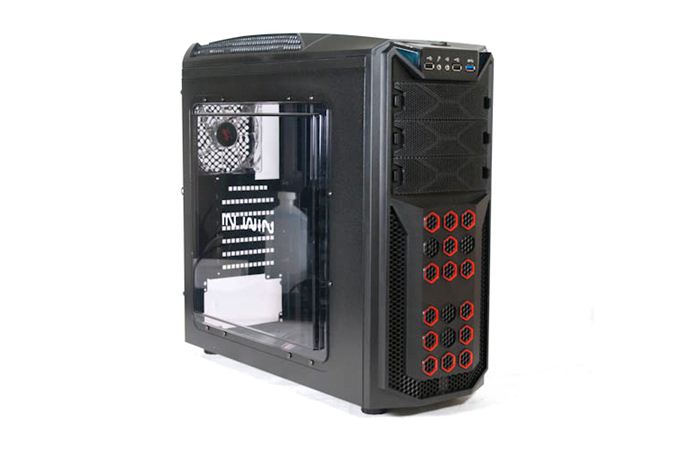
Introducing the In-Win GT1
If you've ever looked at a builder's guide for a desktop system on any major tech site (including this one), you've undoubtedly noticed that the first thing to get cut to make room in the budget is the enclosure. It's not hard to see why; as long as a case keeps things cool enough and runs quietly enough, for the most part it's doing its job. It's only when you look at the greater ecosystem of cases that the real sweet spot of the market ($99-$139) becomes more apparent. What this means, though, is that the sub-$99 market is very competitive, and when you start hovering between $50 and $70, it's downright brutal.
That competitive nature has forced manufacturers to get creative about fitting feature rich cases into lower price tags, and one of those cases is on hand today: the In-Win GT1. The GT1 features a hotswap bay, USB 3.0 connectivity, a semi-modular drive bay, and fan control, and comes in with an MSRP of $69. There's potential for this case, but does it offer enough to beat the incumbent in this bracket, the $10 cheaper Antec GX700?
.jpg)
I hesitate to say "amusingly," but it's the word appropriate for how I feel about this: amusingly, the one place you almost always have to make a sacrifice in this market is aesthetics. The Antec GX700 is a stellar performer, but it's not much of a looker. The In-Win GT1 threatens to fall into the same trap and may only appeal to a specific type of user. In-Win's strapped the bulk of features in the GT1 to a case that's inspired by racing cars.
| In-Win GT1 Specifications | ||
| Motherboard Form Factor | Mini-ITX, Micro-ATX, ATX | |
| Drive Bays | External | 3x 5.25" |
| Internal | 6x 2.5"/3.5", 2x 2.5" | |
| Cooling | Front | 1x 120mm intake fan (supports 2x 120mm) |
| Rear | 1x 120mm red LED exhaust fan | |
| Top | 2x 120mm fan mount | |
| Side | - | |
| Bottom | 1x 120mm fan mount | |
| Expansion Slots | 7 | |
| I/O Port | 2x USB 2.0, 1x USB 3.0, 1x Headphone, 1x Mic | |
| Power Supply Size | ATX | |
| Clearances | HSF | 160mm |
| PSU | 160mm with bottom fan / 220mm without | |
| GPU | 270mm with drive cage / 408mm without | |
| Dimensions |
18.7" x 8.3" x 19.3" 475mm x 210mm x 491mm |
|
| Weight | 12.5 lbs. / 5.6 kg | |
| Special Features |
USB 3.0 via internal header Dual-mode fan controller Removable drive cage panel Side window Toolless drive installation SATA hotswap bay |
|
| Price | $69 | |
In-Win seems to have saved most of their scratch by only including two fans, which isn't unusual for this price range. More disappointing is opting to use 120mm fans instead of 140mm ones; Fractal Design in particular has been putting this foot forward and really, as far as fans go, bigger is usually better. The GT1 doesn't have the room for a 140mm exhaust fan, but it really should've fit one as an intake.
Unfortunately, In-Win also tags what's fast becoming one of my biggest pet peeves in case design: odd-numbered USB ports. I hate the idea that they might have omitted a second USB 3.0 port just to save a buck or two on manufacturing, and it's indicative of an old style of thinking that just doesn't fly on American shores. Designers need to realize that something like this can actually seriously hamstring a case's chances in the market; remember that Antec's GX700 features two USB 2.0 and two USB 3.0 ports.
In and Around the In-Win GT1
I don't want to start the review on such a down note because it's important that In-Win get a fair shake, but the styling on the GT1 is...problematic. The inspiration from racing cars isn't awful, but a case is not a car (or a box of ammunition for that matter), and unfortunately the GT1 turns into the kind of ostentatious case design that even old stalwarts like Thermaltake are starting to move away from. This isn't the ugliest case I've ever tested (that's a dubious distinction reserved for the Cougar Challenger), but with limited exception I think most of you will agree the GT1 isn't going to win any beauty contests.
.jpg)
The front of the GT1 features the I/O cluster at the top, above three 5.25" drive bays with mesh covers, and then an unusual mesh intake design on the front. The odd-colored honeycomb is meant for user customization; you can add or remove the red rings as you see fit. Unfortunately the lights that surround the I/O at the top are blue LEDs; dim ones, but those lights are also intended to be connected to the IDE activity lead and I can see them getting disconnected in a hurry.
.jpg)
In-Win continues the auto and honeycomb motif on the top of the enclosure. There's an indented SATA hotswap bay that sits behind the power button, reset button, and fan control. The fan control is a single switch that shifts between "Silence" and "Turbo" modes, and as you'll see later, it's more than a little bit clunky. There's a massive window with an In-Win logo on the side panel, but both panels are extruded. I appreciate the symmetry, at least; extruding the panel behind the motherboard tray improves space for cable management at least.
.jpg)
Remove the thumbscrews from the two side panels and pop them off (they use the dreaded notched mounting system) and you can get to the meat of the GT1. There are a few interesting things going on in here. First is that the mounting stand-offs are extruded from the motherboard tray, which will make mounting our test board much easier. Second, the cabling channel is surprisingly narrow, as are the routing holes, and this does cause some problems down the road. Third, the case's existing wiring routes fan lines beneath the motherboard. I don't think this is a particularly bad idea, it's just unique. Fourth, there could've been support for seven drive trays in the cages, but In-Win only includes six, and opts not to notch the set of rails below the top two trays.
The reality is that some of the design choices in the GT1 are really smart, and others are baffling. Features have basically been left on the table for reasons I can't understand (but are likely related to cost.) There's space for a seventh drive sled in the case, but they simply don't include it. They could've gone with two USB 3.0 ports and just forgone USB 2.0 entirely, but they didn't. When we get to cabling, you'll see how they cut corners on the fan controller, too.
Assembling the In-Win GT1
In-Win's GT1 gets to be the first benefactor of our shiny new testbed motherboard. Our old Z68 micro-ATX board ran into a serious problem: it wasn't splitting CPU PCIe lanes to the second PCIe x16 slot for SLI, which is the "next level" of testing. Even though I tried just as hard as I could to find another comically undersized board to install in our enthusiast cases, unfortunately I had to get a full ATX board that would be more representative of what users might build with. Rejoice, my year of spiting readers complaining about the micro-ATX board is over! (Actually, you guys were right. The added flexibility of using a micro-ATX board wasn't worth the downsides. Mea culpa.)
Because In-Win included motherboard standoffs effectively extruded from the motherboard tray, installing our new test board was actually a very simple affair. They do include additional standoffs if you're using a smaller board like the previous test board, though. Wiring the motherboard was also easy enough to do, but In-Win includes two power LED leads: one for three pin spaces, another for two, instead of just splitting the positive and negative leads.
.jpg)
The toolless drive installation also went absolutely swimmingly. For 5.25" drives, the toolless clamp is secure and the bay shields themselves pop in and out easily enough without being frustratingly loose. 3.5" drives fit snugly into the trays; the trays themselves are a pretty sturdy plastic with exactly enough flex, and pins snap into the side screw holes of the drives. 2.5" drives can be bottom-mounted to the trays, but In-Win also includes two dedicated installation points for 2.5" drives. The second is in the bottom of the case, beneath the last drive tray, but the first is actually at the bottom of the top drive cage. There are two wedges that slot into the side screw holes of the 2.5" drive; you angle the drive in, then screw in the other side, and it's held into place securely. You do have to remove the left panel of the cage first, though; that's held in place by a single screw.
Mounting the power supply went easily enough, but when we get to the expansion cards we see another place where In-Win cut costs. The expansion slots are covered by perforated steel instead of actual slot covers, so once you pop 'em out, they're open for business forever unless you buy some aftermarket covers. The steel In-Win used for the case is actually pretty damn sturdy, too, and I was surprised at how much force I had to apply to eventually remove the covers.
.jpg)
Where installing our testbed into the GT1 goes haywire, though, is the cabling. There are a couple of major problems going on here. First, there's no routing hole for the AUX 12V line, so you'll have to run it across the motherboard. Second, the routing holes that feed into a channel around the motherboard aren't just small, they're actually already mostly occupied by the case's leads.
.jpg)
The third problem is the biggest, in my opinion. Our review unit came with all the fans and fan controller connected incorrectly. The fan controller used in the GT1 isn't like the ones I've seen in other cases; it's a single three-pin lead connected to a molex adapter, and if you plug the chain of fans into the wrong side of the sequence, all the fans just run at full speed. That's exactly how the GT1 shipped to me, and if it hadn't dawned on me after a deep and restful sleep to go back and recheck the connection order, this review would be missing an entire set of results and the fan controller declared bunk.
Putting together the GT1 was ultimately fairly easily, but was heavily marred by the cable routing issues and the incorrectly-assembled fan control. I will tell you that with both video cards installed (along with everything else), this case gets cramped in a hurry, but that's to be expected from a mid-tower.
Testing Methodology
For testing full ATX cases, we use the following standardized testbed in stock and overclocked configurations to get a feel for how well the case handles heat and noise.
| ATX Test Configuration | |
| CPU |
Intel Core i7-2700K (95W TDP, tested at stock speed and overclocked to 4.3GHz @ 1.38V) |
| Motherboard | Gigabyte GA-Z77X-UD4H |
| Graphics Card |
ASUS GeForce GTX 560 Ti DCII TOP (tested at stock speed and overclocked to 1GHz/overvolted to 1.13V) 2x NVIDIA GeForce GTX 580 in SLI (full fat testing only) |
| Memory | 2x2GB Crucial Ballistix Smart Tracer DDR3-1600 |
| Drives |
Kingston SSDNow V+ 100 64GB SSD Samsung 5.25" BD-ROM/DVDRW Drive 3x HGST DeskStar 3TB 7200-RPM HDD |
| CPU Cooler | Cooler Master Hyper 212 Evo with Cooler Master ThermalFusion 400 |
| Power Supply | SilverStone Strider Plus 750W 80 Plus Silver |
Each case is tested in a stock configuration and an overclocked configuration that generates substantially more heat (and thus may produce more noise). The system is powered on and left idle for fifteen minutes, the thermal and acoustic results recorded, and then stressed by running seven threads in Prime95 (in-place large FFTs) on the CPU and OC Scanner (maximum load) on the GPU. At the end of fiteen minutes, thermal and acoustic results are recorded. This is done for the stock settings and for the overclock, and if the enclosure has a fan controller, these tests are repeated for each setting. Ambient temperature is also measured after the fifteen idle minutes but before the stress test and used to calculate the final reported results.
For the "full fat" testbed, the GTX 560 Ti is swapped out for a pair of GTX 580s, and three hard disks are added to fill out the case.
Thank You!
Before moving on, we'd like to thank the following vendors for providing us with the hardware used in our testbed.
- Thank you to Puget Systems for providing us with the Intel Core i7-2700K.
- Thank you to Gigabyte for providing us with the GA-Z77X-UD4H motherboard.
- Thank you to Crucial for providing us with the Ballistix Smart Tracer memory.
- Thank you to Cooler Master for providing us with the Hyper 212 Evo heatsink and fan unit.
- Thank you to Kingston for providing us with the SSDNow V+ 100 SSD.
- Thank you to CyberPower for providing us with the Samsung BD-ROM/DVD+/-RW drive.
- Thank you to HGST for providing us with the trio of hard drives.
- And thank you to SilverStone for providing us with the power supply.
Noise and Thermal Testing
When testing the In-Win GT1, expected performance isn't really relevant. The bottom line here is that In-Win has to beat Antec's GX700 because unless the user specifically needs the hotswap bay, the GX700's lower price and smarter fan controller are going to be a better draw.
There's an important note that needs to be made when comparing the GT1's results to previous test results. I've endeavored to get the new motherboard to produce thermal results nigh identical to the old one's, but motherboards can be quirky creatures. In my testing, I've found that while almost all results are comparable between the new bed and the old one, the margin of error on CPU thermals increases by about 2C when comparing to the old board. The new board also polls the core temperatures more frequently, which results in a notably lower overall idle temperature measurement, so keep that in mind. Idle temps on the CPU generally aren't a huge deal unless the delta is over 10C (which basically never happens), but this is worth noting nonetheless.
Ambient temperature for testing hovered around 22C, and the GT1 was tested with both fan settings.
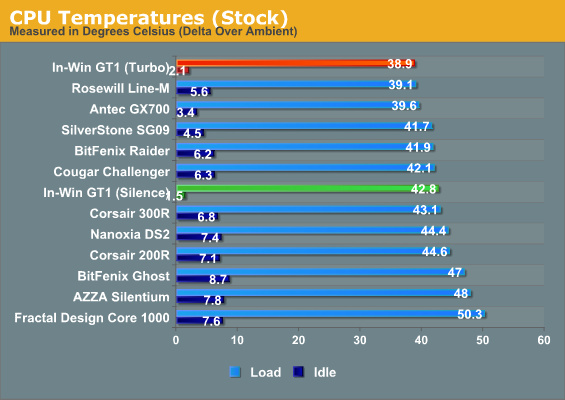
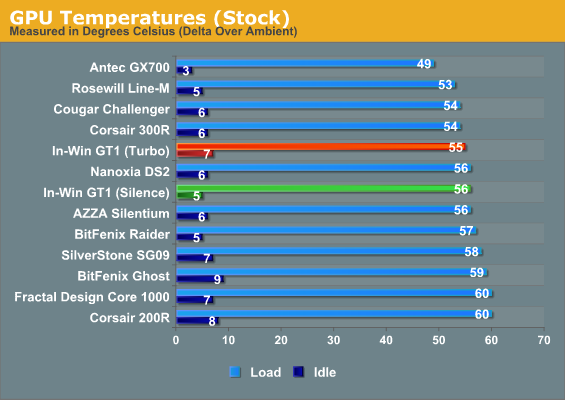
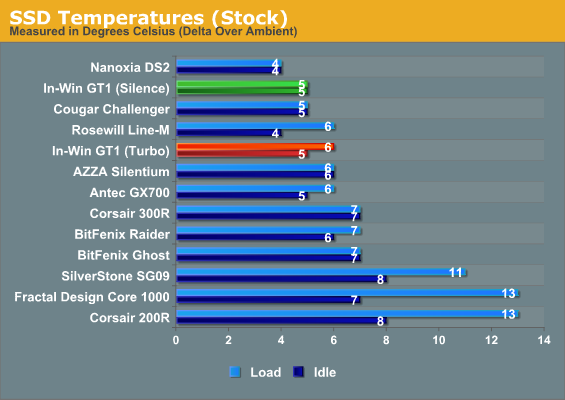
At its turbo setting, the GT1's CPU thermals are competitive with the GX700's best, but everything else is pretty much a wash. Unfortunately, the turbo setting also takes its toll on acoustics.
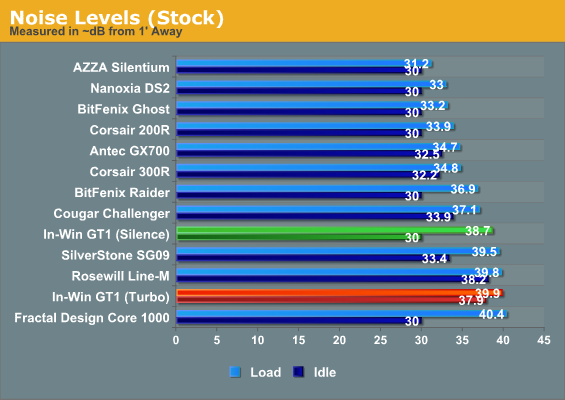
At its loudest the GX700 is still mighty efficient, while the GT1 produces a heck of a racket. The fact is that the GT1 just doesn't possess the cooling power to compete with the pair of 140mm fans in the top of the GX700.
The overclocked settings don't really help the situation.
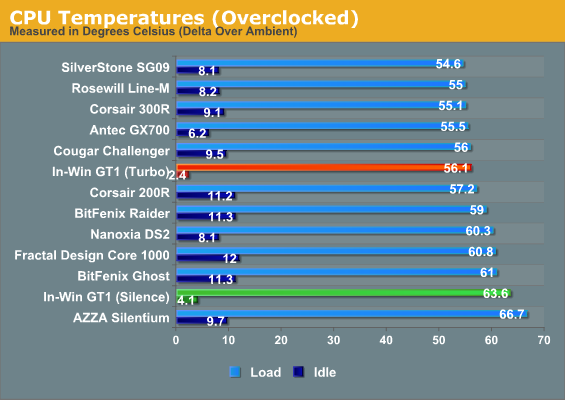
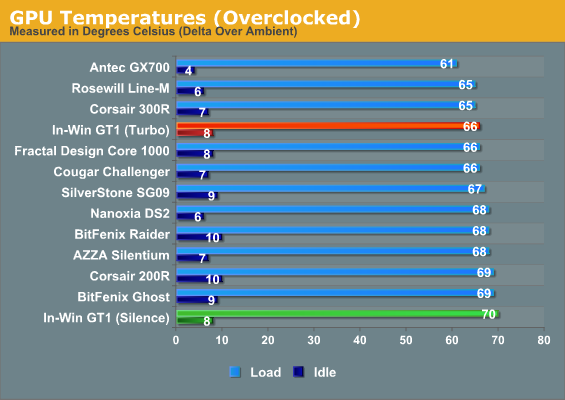
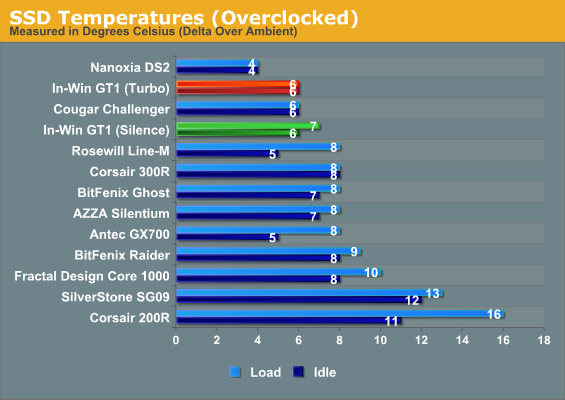
At its turbo setting, the GT1 is competitive; at its silent setting, it can keep the video card cool but the CPU loses a lot of thermal headroom.
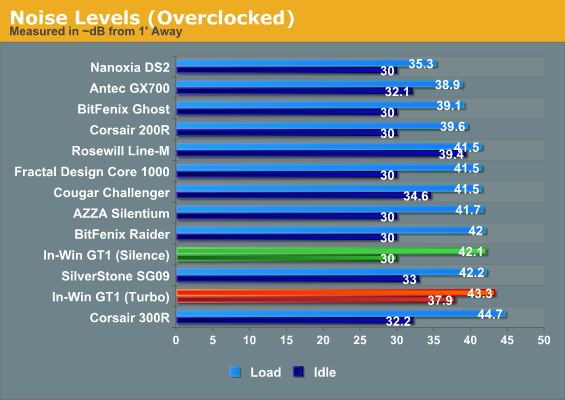
Unfortunately that "silence" setting is only good for idle noise; when the system kicks up it becomes one of the loudest we've tested. The more open air design of the GT1 does the end user no favors when it comes to noise.
Finally, I loaded the GT1 up with two GTX 580s in SLI and three hard drives to obstruct the front fans.
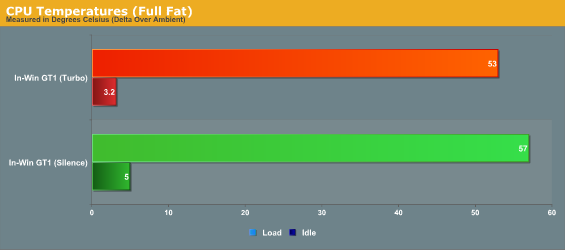
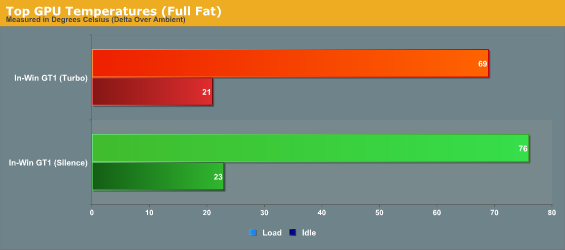
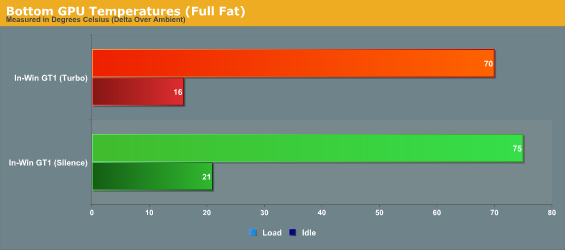
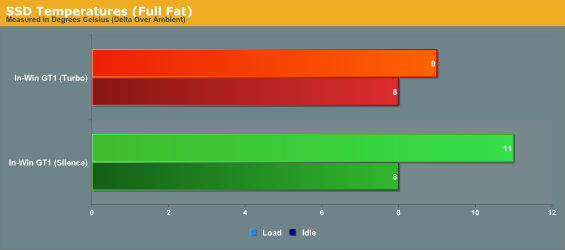
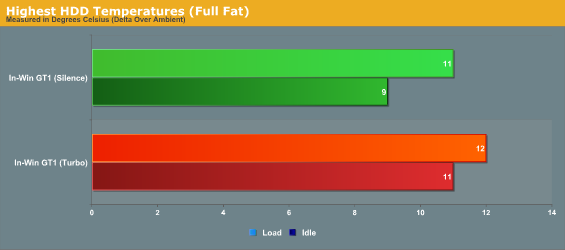
We don't have any comparative data yet, but we can at least say a couple of things for certain. First, the CPU actually runs cooler in this configuration than our standard overclocked one due to the blower coolers on the GTX 580s exhausting hot air instead of feeding it back into the case. Second, the GTX 580s are working hard. Top GPU temperatures were actually roughly the same between the two cards because they were both hitting thermal limits at around 92C-93C.
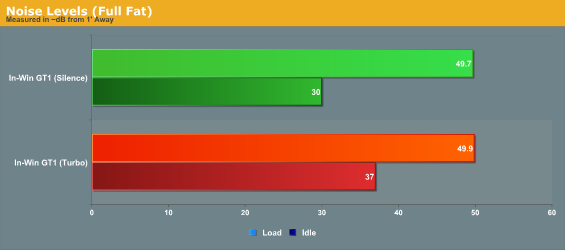
And the noise levels tell the rest of the story. Once the system was placed under load, the fans on the GTX 580s swallowed everything else alive and pushed the GT1 to nearly 50 decibels. In other words, this case is loud, and while you can put two high performance cards in it, I wouldn't recommend doing so. It can only barely handle this kind of configuration.
Conclusion: Cutting the Strangest Corners
I want to be more bullish on the In-Win GT1. I actually quite like In-Win and they have some incredibly unique designs in their stable. Maybe not ones suited to pet owners or people with small children, but any of the enclosures in their Frame line has something to offer. I'm even fond of the BUC; while it's not the sexiest case on the shelf, it does have a great personality.
At $69, the GT1 brings a few things to the table. It's for the most part easy to assemble (excluding cabling issues), and it does come fairly fully-featured. The fan controller is funky, but it's there, and for some users the hotswap bay is going to be a compelling add-on. In-Win also seems to be using a thicker grade of steel than competing cases are; the GX700 practically blows over in a stiff wind by comparison. For an inexpensive case, the GT1 is at least trying to offer something to users that its competitors aren't, and I'm glad build quality didn't completely go by the wayside to hit that price tag.
.jpg)
The problem is that the GT1 is entering an incredibly competitive market. $69 is too much for the case, full stop. At $59 you could argue for it over the GX700; maybe not successfully, but at least the GT1 could be part of the conversation. And while the case materials don't seem to have been where In-Win made their unkind cuts to hit their price tag, there are other weird corners cut in their stead. The single USB 3.0 port is frustrating, and there's absolutely no reason they couldn't have included a seventh drive tray. Does the case need it? I'd argue it does, if only for the sake of being complete.
Then there's the fan controller, and to me that's pretty much the kiss of death. The fan controller sports a single 3-pin header that's been converted to molex, but the connection sequence being incorrect out of the box is inexcusable. A computer case is a computer case: it should just work. They cheaped out on the fan controller with just two speeds, and then they didn't cover their tracks. Does a $69 case even need one? It's appreciated, but if they were going to bungle it they might as well have not included it in the first place.
I want In-Win to do well like any other manufacturer, because competition is always good for the end user and good ideas come from all corners of the industry. Unfortunately, the In-Win GT1 is a bust, and your money is better spent elsewhere.

_thumb.jpg)
_thumb.jpg)
_thumb.jpg)
_thumb.jpg)
_thumb.jpg)
_thumb.jpg)
_thumb.jpg)
_thumb.jpg)
_thumb.jpg)
_thumb.jpg)
_thumb.jpg)
_thumb.jpg)






